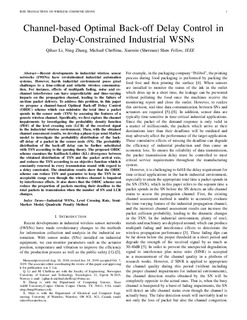| dc.contributor.author | Li, Qihao | |
| dc.contributor.author | Zhang, Ning | |
| dc.contributor.author | Cheffena, Michael | |
| dc.contributor.author | Shen, Xuemin (Sherman) | |
| dc.date.accessioned | 2019-11-20T14:01:14Z | |
| dc.date.available | 2019-11-20T14:01:14Z | |
| dc.date.created | 2019-10-27T14:46:57Z | |
| dc.date.issued | 2019 | |
| dc.identifier.issn | 1536-1276 | |
| dc.identifier.uri | http://hdl.handle.net/11250/2629560 | |
| dc.description.abstract | Recent developments in industrial wireless sensor networks (IWSNs) have revolutionized industrial automation systems. However, harsh industrial environment poses great challenges to a time-critical and reliable wireless communication. For instance, effects of multipath fading, noise and cochannel interference can have unpredictable and time-varying impacts on the propagation channel, leading to the failure of on-time packet delivery. To address this problem, in this paper we propose a channel-based Optimal Back-off Delay Control (OBDC) scheme which can minimize the total time a packet spends in the sensor node (TSN) by assessing the features of a generic wireless channel. Specifically, we first explore the channel impairments by investigating the probability density function (PDF) of the level crossing rate (LCR) of the received signal in the industrial wireless environment. Then, with the obtained channel assessment results, we develop a phase-type semi-Markov model to investigate the probability distribution of the backoff delay of a packet in the sensor node (SN). The probability distribution of the back-off delay can be further substituted with TSN according to the queuing theory. The proposed OBDC scheme examines the Kullback-Leibler (KL) divergence between the obtained distribution of TSN and the packet arrival rate, and reduces the TSN according to an objective function which is constantly renewed in every transmission round with regard to a delay constraint. The simulation results show that the OBDC scheme can reduce TSN and guarantee to keep the TSN in an acceptable range even though the wireless channel is impaired by interference effects. It also shows that the OBDC scheme can reduce the proportion of packets meeting their deadline to the total packets in transmission when the number of SN and LCR changes. | nb_NO |
| dc.language.iso | eng | nb_NO |
| dc.publisher | Institute of Electrical and Electronics Engineers (IEEE) | nb_NO |
| dc.title | Channel-based Optimal Back-off Delay Control in Delay-Constrained Industrial WSNs | nb_NO |
| dc.type | Journal article | nb_NO |
| dc.type | Peer reviewed | nb_NO |
| dc.description.version | acceptedVersion | nb_NO |
| dc.source.journal | IEEE Transactions on Wireless Communications | nb_NO |
| dc.identifier.doi | 10.1109/TWC.2019.2948156 | |
| dc.identifier.cristin | 1740933 | |
| dc.description.localcode | © 2019 IEEE. Personal use of this material is permitted. Permission from IEEE must be obtained for all other uses, in any current or future media, including reprinting/republishing this material for advertising or promotional purposes, creating new collective works, for resale or redistribution to servers or lists, or reuse of any copyrighted component of this work in other works. | nb_NO |
| cristin.unitcode | 194,64,94,0 | |
| cristin.unitname | Institutt for vareproduksjon og byggteknikk | |
| cristin.ispublished | false | |
| cristin.fulltext | postprint | |
| cristin.qualitycode | 2 | |
